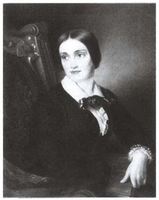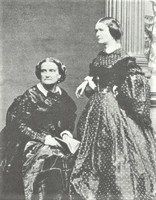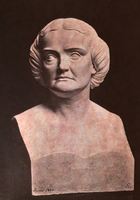New York Times, Stebbins and Cushman, Aug 31, 1860
Dublin Core
Title
New York Times, Stebbins and Cushman, Aug 31, 1860
Subject
Stebbins, Emma, 1815-1882
Cushman, Charlotte Saunders, 1816-1876
Artists--Sculptors--US American
Italy--Rome
Praise
New York Times
Arts--Sculpture
Gender Norms
Publisher
New York Times
Date
1860-08-31
Type
Reference
Article Item Type Metadata
Text
"but a New-Yorker, Miss EMMA STEBBINS, who has done like justice to still other features of our life, undoubtedly is; and the great City may well rejoice in her daughter. Sculptresses (since we must use so odious a word,) are a feature of the age we live in, and America has contributed her proportion to the common glorification of the female chisel. Yet, at the risk of sharing the fate of Orpheus, we shall venture to say that the promise of a new work by the said female chisel does not commonly elate us. Our reasons we may hereafter put forward; for the present we state the fact only that the reader may excuse the warmth with which we may have been inspired in the case of the delightful disappointment prepared for us by Miss STEBBINS' statuettes of the "Miner" and the "Sailor," and by her incomparable bust of Miss CHARLOTTE CUSHMAN. We have already spoken in these columns of one of these works, the "Miner," described with no stint of praise in a letter from Rome, which we published more than a year ago. With its companion figure of the "Sailor," this statue was then pronounced the finest achievement in marble yet reached by female genius at Rome. We took the praise at the time with a pinch of salt; but it is our duty now to say that we have thrown the said salt over our left shoulder. One of these days, perhaps, the fortunate proprietor of these prizes may give the public an opportunity of testing the accuracy of our words; but in the interval, we risk ourselves frankly on an unqualified indorsement of our Roman correspondent. The whole spirit of American labor, honest, fearless, young, high-spirited yet manly, dignified, respectful and self-respecting, speaks in these stately and graceful figures. Modern in face as in costume though they be, the antique art itself revives in the typical beauty which breathes from them. For they have grown up, not out of a sentiment only, but out of a serious and sustained study of anatomy, which indicates itself in the masterly poise and harmonized vigor of the figures. In the ideal refinement of the treatment you recognize a woman's thought and a woman's eye; but in the laborious, earnest accuracy striven for throughout, a sense appears of the supreme value of defined and logical expression which the common, and, as we heretically believe, the correct opinion of sages and scholars, refuses to the daughters of Eve. This is equally true of Miss STEBBINS' bust of Miss CUSHMAN, although the most superficially striking quality of this very remarkable portrait is the feminine softness and purity, the positive radiance of the atmosphere it carries with it. The grander features of Miss CUSHMAN's head are familiar to all who know the tragic artist; the womanly nature of the woman comes to us in this bust translated by a woman's intimate tenderness. The face is full of what the Germans, who don't stick at trifles when they want to utter their minds, call "inwardness;" full, not of the fame which flickers and burns into life on the stage, but of the enduring qualities which make fame worth having when it is won. Of course, this peculiar and fascinating merit of the bust in question must be carrted largely to the account of a peculiar intimacy between the artist and the sitter. But it is a high artistic merit nevertheless, for who thinks the worse of RUBEN's as an artist that he painted his own portrait better than the portrait of anybody else? It is an early stage in art at which the skillful hand can reproduce what the head calmly elaborates. To carry steadily the full cup of feeling, and put into the stern and rigid categories of expression the finest and most tremulous motions, is a far higher flight of power; and it is because we recognize in Miss STEBBINS' works the consciousness of this truth, and the capacity to face its demands, that we predict for her on the strength of what we have already seen, a place among the elect of an art which, with Mr. HAWTHORNE's and Mr. RUSKIN's permission, we do not believe has the slightest intention of dying, to oblige a theory."
Provenance
Unknown. “American Art-Recent Works of American Artists.” New York Times, 31 Aug. 1860, www.nytimes.com/1860/08/31/archives/american-artrecent-works-of-american-artists.html. Accessed 11 Dec. 2019.
Social Bookmarking
Geolocation
Collection
Citation
“New York Times, Stebbins and Cushman, Aug 31, 1860,” Archival Gossip Collection, accessed April 18, 2024, https://www.archivalgossip.com/collection/items/show/112.




